Among the accessories for women that are in high demand are: crocheted scarf, the diagram and description of which can be easily found on the Internet. Successfully selected yarn and the tool used allow you to create a unique wardrobe attribute that harmoniously matches a certain type of clothing.
Further in the article, some methods of knitting openwork shawls, options for the threads and hooks used are considered, and patterns for kerchiefs of varying degrees of complexity are presented.
Choosing yarn and tools for knitting a shawl
Unfortunately, not all shawl patterns presented on the Internet contain a detailed description of their execution, as well as information on the recommended yarn and hook number. Therefore, those wishing to use such patterns must independently select the optimal thickness and structure of the thread, as well as the most suitable hook number.

For hand knitting, various types of yarn are used, which are divided into natural, mixed, artificial and synthetic.
More detailed information about them is presented in the table:
| Type of yarn | Description | Name |
| Natural | This type of yarn is made from natural plant or animal raw materials. These can be plant fibers or animal wool. Positive qualities: high hygroscopicity, thermal conductivity, pleasant organoleptic properties, excellent quality characteristics. Negative qualities: easily creased, quite expensive material. | Linen, cotton, silk, bamboo, alpaca, wool, cashmere, mohair. |
| Mixed | The most common type of yarn today. It consists of mixing different percentages of natural raw materials and synthetic fibers.
Positive qualities: high strength, sufficient quality characteristics, hygroscopicity and thermal conductivity are slightly lower than those of natural yarn, but still at a good level, low wrinkling, pleasant to the touch, optimal cost. There are practically no negative qualities. | Linen, cotton, silk, bamboo, alpaca, wool, cashmere, mohair with the addition of acetate fiber, acrylic, lurex, nylon, lavsan. |
| Artificial | This type of yarn includes threads made from natural raw materials, but subjected to chemical treatment. With its help, the yarn minimizes or completely eliminates the shortcomings inherent in natural fiber. These include increased rigidity, unevenness, wrinkling, prickliness. Thanks to chemical procedures, the thread becomes smooth, soft, pliable, comfortable both in work and in the finished product. | Atlas, viscose. |
| Synthetic | Such yarn is produced entirely artificially. Synthetic fiber has the lowest cost among all types of threads. This is due to rather low quality characteristics: poor hygroscopicity, low thermal conductivity, uncomfortable organolytic properties, the presence of burrs, thickenings, increased looseness, uneven twist. | Acrylic, acetate silk, polyamide, polyester, lurex, nylon, nylon. |
To carry out the work manually, it is necessary to select threads only for these purposes. To obtain more complete and detailed information about the characteristics of the yarn, you should definitely pay attention to the label of the skein.
It indicates:
- country and brand of manufacturer;
- precise composition;
- the weight of the skein and the meter of thread in it;
- recommended knitting tools (their type and number);
- approximate web density when using the specified tools;
- acceptable and unacceptable care procedures for finished products made from this yarn.
Based on the data provided, it will not be difficult to calculate the yarn consumption and the number of skeins required to make a particular scarf.
It is not recommended to take as a basis the density indicated on the label of the threads. This is due to the fact that each needlewoman has an individual density and can differ significantly from what is written. Therefore, when calculating the amount of yarn, you should make a reserve for a possible discrepancy in knitting density.
Also, depending on the hook number used in the work, the density of the fabric may change. If a smaller hook than indicated on the label is used, the number of loops and rows will be greater. This, accordingly, will increase the density of knitting. And vice versa, if a hook of a larger number is used, the fabric will be looser and airier. Consequently, its density will be less.
The optimal combination of thread and hook thickness is presented in the table:
| Thread thickness in 100g | Hook number |
| 100 m | 4-6 mm |
| 200 m | 3-4 mm |
| 250-350 m | 2.5-3 mm |
| 300-500 m | 2-2.5 mm |
| 1600-2000 m | 1-2 mm |
For yarn lengths less than 100 m, use thick hooks of 6 mm or larger.
Another nuance that should not be neglected when choosing yarn for crocheting is the twist of the thread. It should be dense and strong. Otherwise, it will delaminate during work, and it will be difficult to grab with a hook. As a result, the fabric will be of poor quality and uneven.
Knitting from the corner
The crochet scarf for a woman, the diagram and description of which are presented in this section, has its own peculiarity. It consists in the beginning of the work. Such a shawl is started to be knitted from the bottom corner. Evenly adding loops on each side, the scarf is knitted to the required dimensions.
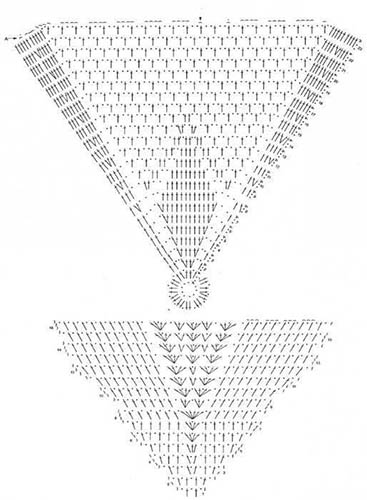
At the beginning of work in this way, it is advisable, after knitting several rows, to bring the angle of inclination of the sides into line. This determines what shape and what parameters the future product will have. If the expansion of the fabric is slow, then the finished shawl will be elongated with a small swing of the upper ends.
And, conversely, with a large addition of side loops, the angle of inclination of the sides of the kerchief increases, which ultimately leads to a product that is small in height, but with a large span of the upper ends.
The undoubted advantages of this method of knitting scarves are:
- use of different types and numbers of patterns (monotonous simple, located in the center or corner of the scarf, symmetrical);
- the possibility of increasing the size of the fabric by knitting its upper side.
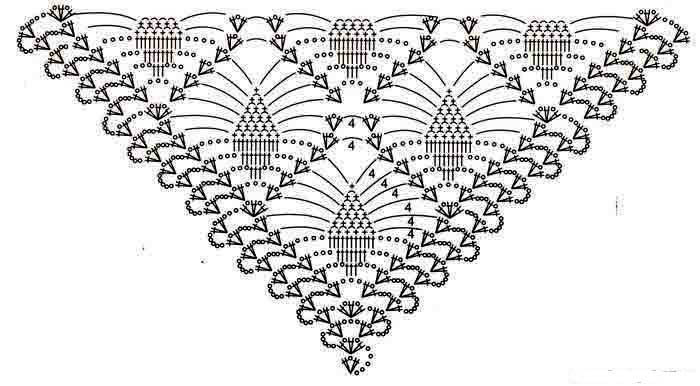
When knitting a shawl with a pattern you like without a diagram, you must always maintain symmetry when working. Before using the ornament, you must select a rapport and start knitting from its middle.
Shawls of this type can be made from both thin and thick yarn, depending on the season of the product. It is better to give preference to yarn from mixed raw materials, in which the proportion of natural fiber will be at least 50%. Such shawls are moderately warm, comfortable, and hold their shape well.

The color scheme of the shawl is an individual approach. It depends on what clothes it will be worn with, what attribute it will be used as. A single-color shawl, made in a similar color to the main product or in the same range, differing only in shade, will emphasize the integrity of the image.
A contrasting shawl will shift the focus to a more advantageous detail of the suit. The multi-color gives the product versatility, allowing it to be worn with various things.
Air scarf
A crocheted scarf for a woman, the diagram and description of which are given below, assumes, mainly, its use as a decorative accessory. This is due to the openwork structure of the knitting and the presence of a large number of holes of various configurations and sizes.
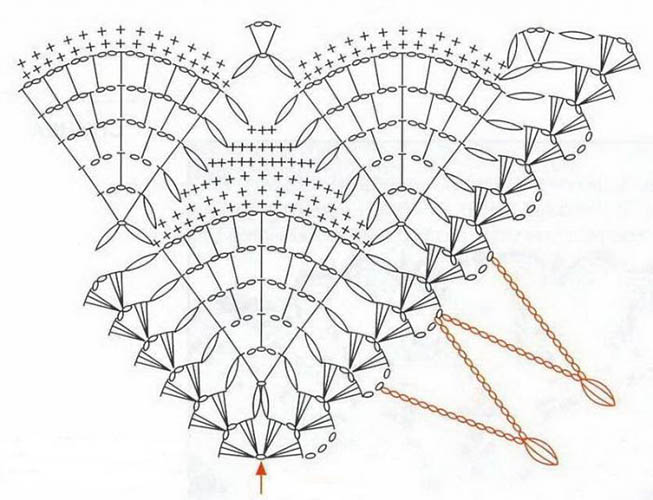
Patterns of openwork shawls are distinguished by both simplicity with a simple ornament and complex elements that require certain skills and experience. But if a beginner knitter has perseverance, patience, excellent attention, the ability to correctly read patterns, such a pattern will be within her power.
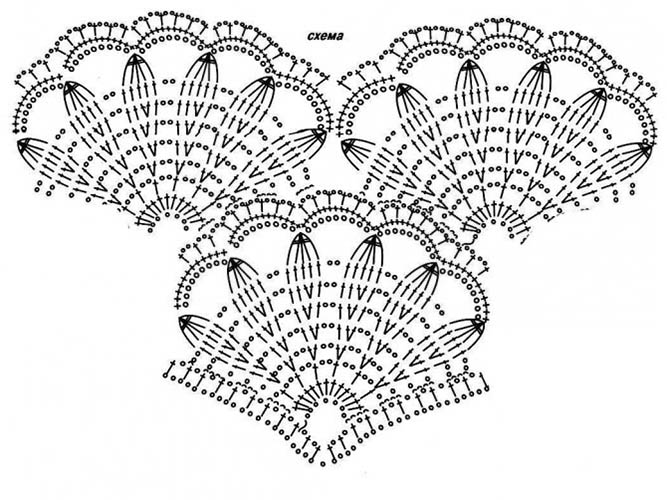
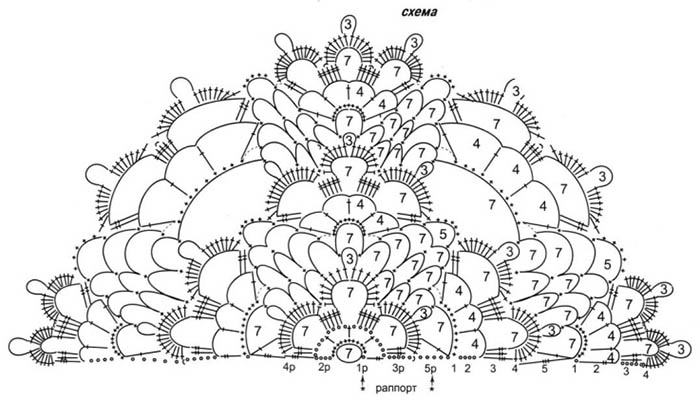
Openwork kerchiefs are made in various techniques and several methods. They are knitted from the corner, from the center, with separate motifs. Detailed information about these methods is presented below.
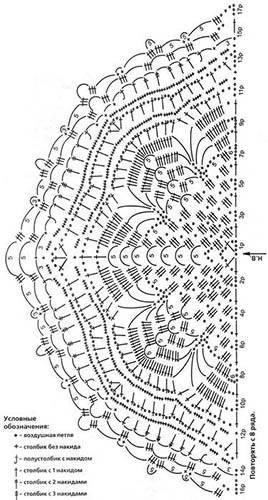
The configuration of openwork shawls can be triangular with straight or figured sides, semicircular with sharp or rounded upper ends.
The pattern scheme is chosen according to the purpose of the product. If it is intended for everyday use, then a simple uniform pattern or one with minimal deviations from it may be an acceptable option.
If the kerchief is used for special occasions and serves as a decorative element in the outfit, then an ornate, multifaceted ornament in such a situation is what you need. Such a shawl is also used as a cape or a kind of bolero, fastened in front with a beautiful pin or brooch.
For knitting elegant openwork shawls, it is better to use thin, high-quality yarn made of mercerized cotton, acetate or natural silk, mixed thread made of cotton with viscose, thin mohair with various additives. Recommended hook sizes are from 1 to 3 mm.
Knitting from the center
A crocheted scarf for a woman (diagram and description below) using the following method starts from the center. This method is also used to knit shawls of various shapes. It is quite convenient, since you can immediately determine the required width of the top edge of the shawl.
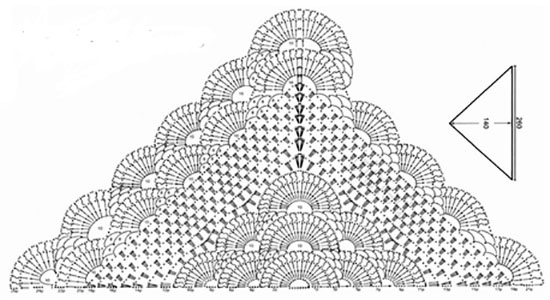
But when using this type of knitting, you should know that the slightest mistake when performing a row on one or the other side of the center will cause distortion of the entire fabric. Therefore, when performing work, it is necessary to very carefully follow the pattern diagram and conduct ongoing control, periodically calculating the number of loops in one row on each side.
If this is not done, then ultimately, if an error is made, one may discover phenomena such as:
- the formation of concave areas on the fabric if there was an accidental shortage of loops in one of the rows;
- the formation of small folds if too many loops were cast on in any row.
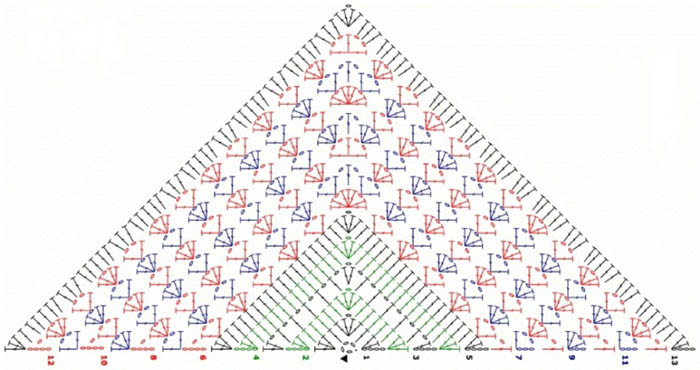
The second point of errors is still allowed when knitting semicircular kerchiefs, but on the condition that the extra loops are collected on both sides of the center of the fabric.
Knitting kerchiefs in this way involves the use of both thin and thick yarn made from natural, mixed and synthetic fibers.
From individual motives
A crochet scarf for a woman (the diagram and description are presented below) is made from separate motifs, connected into one whole piece of fabric. This is an interesting and diverse way of knitting shawls. It would seem that ordinary, with a simple pattern, small squares or circles, skillfully linked together, create truly unique and inimitable products.
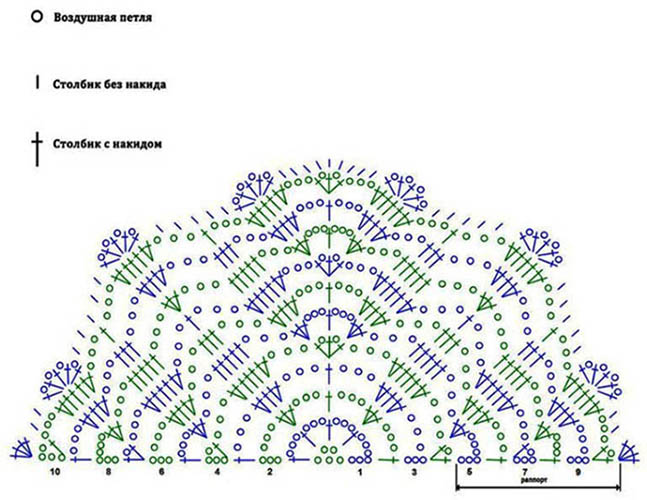
This is a simple and complex knitting method at the same time. The difficulty lies in the correct connection of the fragments to each other and the execution of half an element to fill the spaces formed at the top of the kerchief.
Also, when selecting motifs for a future product, you should pay attention to their shape. This applies to round fragments. The closer the configuration is to a square, the easier and simpler it will be to connect them into a whole piece. Otherwise, it becomes necessary to knit additional small elements to fill the spaces between the main parts.
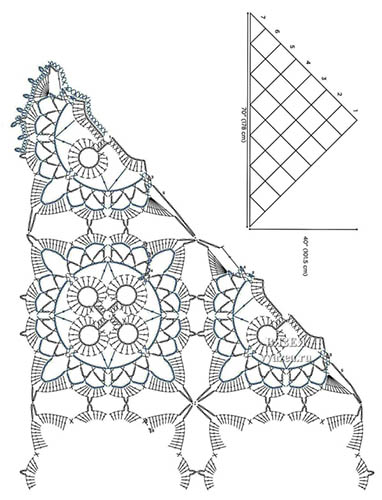
If the fragment you like is round, you can make it look more like a square by knitting the outer row with extended chains of air loops in four places (corners of the square). This technique is clearly shown in the diagram.
It should be further noted that the coupling of separately related motives is carried out in two ways:
- in the process of completing the last row;
- after preparing the required number of elements.
According to experienced craftswomen, the first method is more practical, durable and has a better aesthetic appearance. It is suitable for those beginner needlewomen who have spatial thinking and can mentally follow the next step in the process of work.
If there is no such quality, then the second method will come in handy. Having prepared the required number of individual motifs, they are laid out in the finished product and sequentially, using a needle and thread, connected to each other. Then the shawl is tied on all sides with the desired pattern.
With tassels
One of the old ways to give a knitted scarf elegance, nobility and grandeur is to frame the sides with a fringe of tassels. This is not a difficult process, but it requires perseverance and a large supply of yarn. Tassels made of threads are placed both densely and sparsely on the product.

The uniformity of their attachment can be easily determined by the rows of the main knitting. The yarn tassel itself can consist of an even number of threads. This is due to the fact that when making it, the cut pieces of yarn are folded in half.
The process of making and securing the fringe is as follows:
- Calculate the number of brushes required.
- Cut this number (or double, triple or more) of pieces of yarn of the same length.
- Fold the required number of threads for one tassel in half and use a hook to secure it in the designated place by grabbing the center of the tassel and pulling the ends through the resulting loop. Pull the resulting tassel tightly.
After completing the work, it is advisable to inspect the result and, if minor defects are found in the form of protruding threads in some places, straighten them out.
A crocheted scarf for a woman is one of the most fashionable, but at the same time easy to make wardrobe accessories.
Numerous schemes and descriptions presented on the Internet allow any needlewoman to create a unique image. And the advice and recommendations of experienced craftsmen described in this article will help not only to implement the plan, but also to get maximum pleasure from the work performed.
A crocheted headscarf for a woman is an original, practical and versatile piece of clothing.
Video about crocheting a scarf
Master-kass on knitting a simple crochet scarf for beginners:
